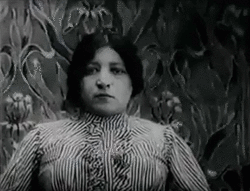Stop-motion
Stop motion is a way of animation which makes it look like still objects are moving. Clay animation is a good example of how stop motion is used.
Stop-motion requires any camera that can make single frames (or photos). It works by shooting a single frame, moving the object a little bit, and capturing a frame again. Cartoons use a similar way; one of the main differences is that stop motion uses real objects instead of drawn.
Tim Burton, Will Vinton and the Aardman studio have used this method in their productions.
Stop-motion Media
Julienne Mathieu in a stop motion/pixilation scene from Hôtel électrique (1908)
The Sculptor's Nightmare (1908); runtime 00:09:10
Émile Cohl's Japon de fantaisie (1907); runtime 00:00:59
Starewicz' The Beautiful Leukanida (1912); runtime 00:10:21
The Dinosaur and the Missing Link (1915); runtime 00:06:13
Excerpt from The Lost World (1925); animation by Willis O'Brien; runtime 00:01:41
Gumbasia (1955) by Art Clokey; runtime 00:03:09
Pat & Mat, two inventive but clumsy neighbors, was introduced in 1976, while the first made-for-TV episode Tapety (translated Wallpaper) was produced in 1979 for ČST Bratislava.
The music video to Green by Cavetown, a modern example of stop motion animation
Related pages
![]()



